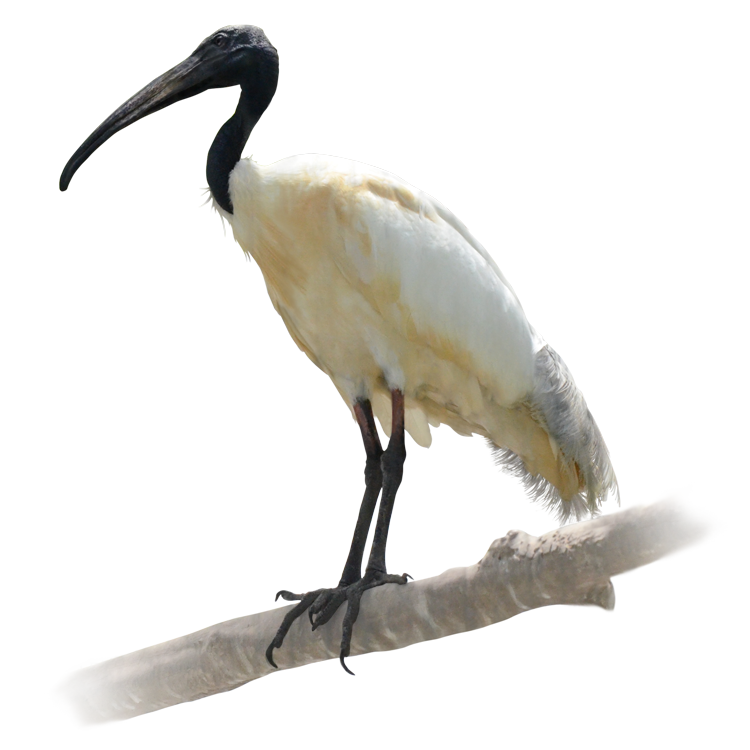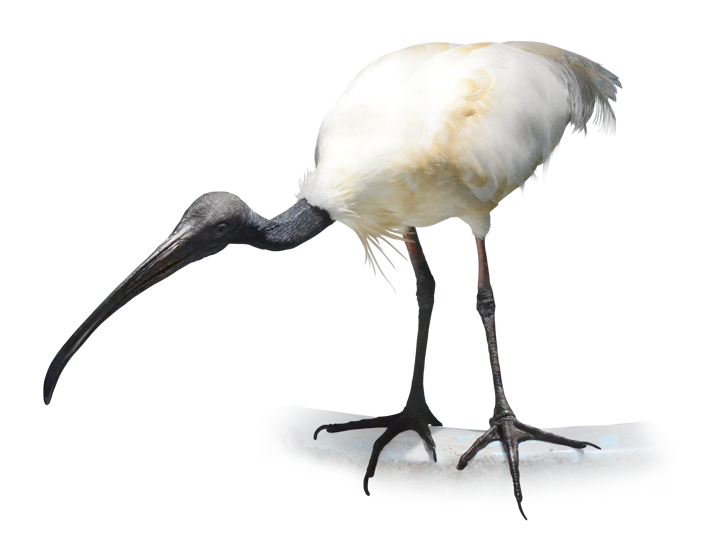
Threskiornis melanocephalus (Latham, 1790)
よく似た3種のクロトキ
Three Very Similar Species of Black Ibis
全長70cm、翼開長130cm。体色は白く、頭部や脚部が黒く、尾羽には灰色が混じります。留鳥としてはインド、スリランカ、ネパール、ミャンマーに生息し、中国東部は繁殖地として、東南アジアには越冬地として生息します。日本でも稀に迷鳥として飛来することがありますが、近年は記録が減少しています。
クロトキ属は6種のクロトキが知られていますが、本種によく似ているのがアフリカのサハラ砂漠以南に生息するアフリカクロトキThreskiornis aethiopicusと、オーストラリアからパプアニューギニアにかけて生息するオーストラリアクロトキThreskiornis moluccaです。クロトキと違いどちらも尾羽が黒いのが特徴です。さらにこれらの2種を見分けるのは脚の色で、黒色なのがアフリカクロトキで、暗褐色なのがオーストラリアクロトキです。オーストラリアクロトキは都市外縁部にまで進出しており、まるでカラスのようにゴミ箱を漁る害鳥として知られています。これらの3種は同一種とみなされることもありましたが、地理的変異による形態の違いから現在では別種とされています。
クロトキは湿地帯に依存する種であり、甲殻類、昆虫、カエル、魚等を餌として暮らしています。環境汚染や土地開発により豊かな水源を喪失し住処を失うと、本来の餌が手に入らなくなり、オーストラリアクロトキの例のように都市部を彷徨うことになります。古くから各地で神聖な存在と敬われてきたクロトキです。その存在価値が揺らぐのは、まさに人間の業と言えます。
It has a total length of 70cm and a wingspan of 130cm. Its body is white, its head and legs are black, and its tail feathers are gray. It lives as a resident bird in India, Sri Lanka, Nepal, and Myanmar, breeds in eastern China, and winters in Southeast Asia. It occasionally comes to Japan as a stray, but records of its arrival have decreased in recent years.
There are six species of black ibis known to exist in the genus Black Ibis, but the two species that are most similar to this one are the African Black Ibis (Threskiornis aethiopicus), which lives in sub-Saharan Africa, and the Australian Black Ibis (Threskiornis molucca), which lives from Australia to Papua New Guinea. Unlike the Black Ibis, both have black tail feathers. The two species can also be distinguished by the color of their legs, with the African Black Ibis being black and the Australian Black Ibis being dark brown. The Australian Black Ibis has spread to the outskirts of cities and is known as a pest bird that scavenges through garbage cans like a crow. These three species were once considered to be the same, but are now considered to be separate due to morphological differences resulting from geographical variation.
The black ibis is a species that depends on wetlands, and feeds on crustaceans, insects, frogs, fish, etc. When rich water sources are lost due to environmental pollution or land development, and they lose their habitat, they are unable to obtain their natural food, and end up wandering urban areas, as in the case of the Australian black ibis. The black ibis has been revered as a sacred being in many places since ancient times. It can be said that the shaking of its value is the work of humans.

参考文献
“Black-headed Ibis” Bird of the World. 2025年7月27日閲覧
“African sacred ibis” Thai National Parks. 2025年7月27日閲覧
チアセブンアーチ | くちばしが長い鳥、オーストラリアクロトキの特徴 | (2024年1月30日) 2025年7月27日閲覧
“Threskiornithidae Ibises and Spoonbills” Bird of the World. 2025年7月27日閲覧
高島 春雄『クロトキに関する知見』 (1956年12月) 2025年7月27日閲覧
Multani TM, Soni HB. Black-headed Ibis Threskiornis melanocephalus (Latham, 1790): a review on ecology, behavior, conservation and management. Biodiversity Int J. 2024;7(2):43-49. 2025年7月27日閲覧